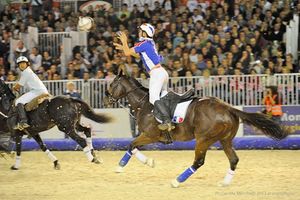Difference between revisions of "Reannangis"
| Line 14: | Line 14: | ||
| contact = Yes | | contact = Yes | ||
| team = 8 players | | team = 8 players | ||
| mgender = Yes, but men and women play in different leagues | | mgender = Yes, but men and women mostly play in different leagues/have seperate national teams | ||
| type = Equestrian, Indoor and Outdoor | | type = Equestrian, Indoor and Outdoor | ||
| equipment = Horse, Club | | equipment = Horse, Club | ||
Revision as of 23:15, 22 August 2018
 An Enskon catching a ball during an attacking move | |
| Highest governing body | ORIS |
|---|---|
| First played | 18th Century, Norjihan |
| Characteristics | |
| Contact | Yes |
| Team members | 8 players |
| Mixed gender | Yes, but men and women mostly play in different leagues/have seperate national teams |
| Type | Equestrian, Indoor and Outdoor |
| Equipment | Horse, Club |
| Presence | |
| Country or region | Baredina, Vaniua |
| Olympic | No |
| World Championships | No |
| Paralympic | No |
Reannangis is an equestrian sport in which teams of 8 compete against each other. The ball is handled, and points are scored by throwing the ball through one of three hoops, dimaeter 1m. The sport first emerged in the 12th century, developed as a training exercises for Norjihani cavalrymen to prepare them for war. These training exercises began to develop into a full blown sport during the 1700s, when it became popular amongst the nobility and especially veterans. Today, the sport is played mostly in [[Baredina] but has also begun to spread to Vaniua. The governing body, ORIS, is based in Tel Duvemuz, Norjihan, and currently has 10 member associations.
Origins
Reannangis, which literally means 'Preparation for War', first emerged as one of a series of regularised military exercises developed for Norjihani cavalry (originally, Reannangis referred to all of these exercises). However, durng the late 17th and early 18th centuries the sport became popular amongst the Norjihani nobility, with several clubs and associations set up playing varying forms of the sport, often regimental in origin, and which became political factions in the courts. The first unified set of rules was developed by one such group, the 'League of Gentlemen of the Horse', an influential group of nobles based in Tel Duvemuz, who carried the favour of the Norjihani King at the time. As a result, their rules - published in 1753 - were adopted quickly, and still form the basis of international standard Reannangis today. The League of Gentlemen of the Horse eventually became ORIS, the governing body of Reannangis.
Rules of play
A 'game' of Reannangis is played between two teams of eight players. A minimum of 5 passes must be made between the Enskons (see below) before they can try to score in one of the three end hoops. The two smaller hoops on either side are worth one point, whilst the larger central hoop, 3.5m back from the other two, is worth 3 points. The sport is played on a rectangular pitch which is 500m by 300m.
There are four roles, or positions, a player can take:
- Enskon - there are 4 Enskons in a team. It is their job to pass the ball between one another and to try and score in one of the three hoops at the opponent's end of the pitch
- Deal - there are 2 Deals per team. Their job is to try and intercept and stop the opposing team by using a club; if a player is hit by the club they forfeit the ball. Up until recently, there were no limits on how hard the club could be swung, but now it must be a tap which the referee can clearly see hits the body of the player (never the horse). Injuries, however, are still not uncommon. They can also hit the ball out of the way, although if it lands on the floor as a result of that, a penalty is conceded. Another common role of the Deal is to protect their team from the opposing Deals, leading to engagements between Deals. The first Deal to be hit by their opponent must return to the end of the pitch and wait 20 seconds.
- Tejiðan - the job of the Tejiðan is simply to try and stop the opponents scoring by protecting the hoops
- Tytikon - The Tytikon's job is to harry the opponent and try to force them to concede possession. The Tytikon is not allowed to touch the ball themselves, but can do anything else to try and force the opponents to lose the ball. Methods of doing this can include but are not limited to charging straight at the opponent or trying to forcefully dismount them.
Players must constantly be moving unless a foul is committed. There are a number of fouls which include but are not limited to:
- Dropping the ball -If you drop the ball and it touches the floor, or as a Deal you hit the ball to the floor, possession is conceded to your opponent who get to begin play from the point the ball landed at.
- Hitting the horse - Hitting the horse of an oppponent, whether with a club, by collision as a Tytikon, or with the ball, results in a free shot at the central hoop being given
- The Tytikon touching the ball - A free ball is given; the team awarded the free ball is given 20 seconds to ride without the opponent being able to counter them